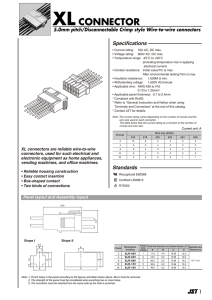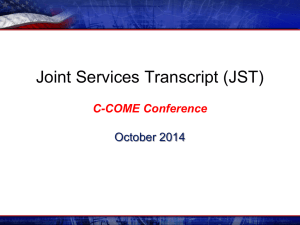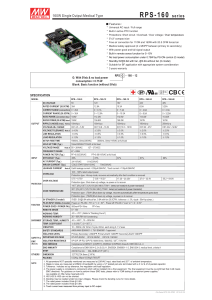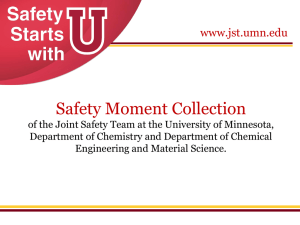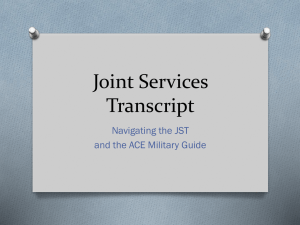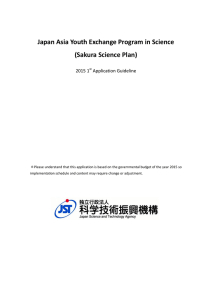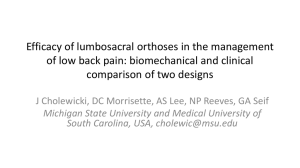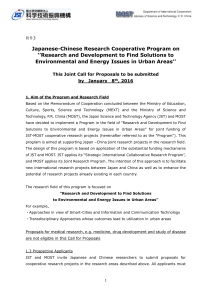DOW Chemical`s Lab Safety Collaboration with the
advertisement
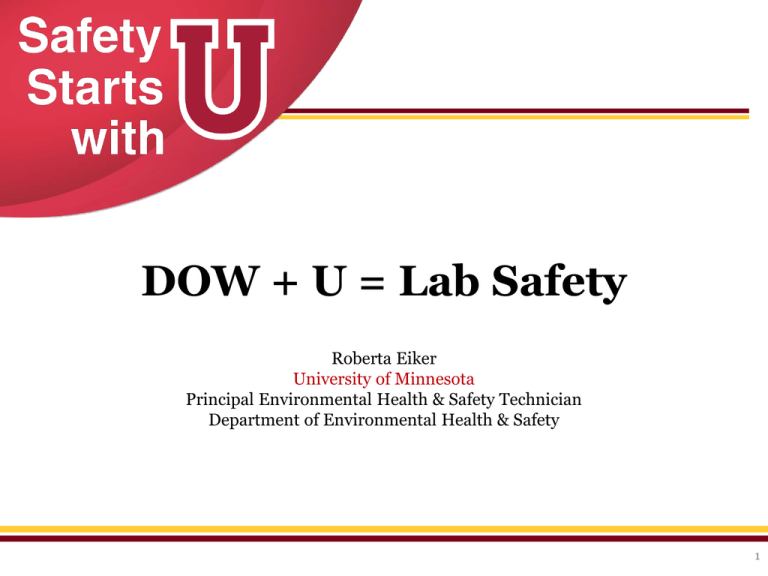
DOW + U = Lab Safety Roberta Eiker University of Minnesota Principal Environmental Health & Safety Technician Department of Environmental Health & Safety 1 Initiative Through a partnership with Dow Chemical the Department of Chemistry, Chemical Engineering, and Materials Science are leading a campaign to improve and sustain the safety culture in laboratories. 2 JST The Joint Safety Team (JST) is a researcherled organization focused on improving the culture of safety in chemical laboratories at the University of Minnesota. The JST consists of all graduate student or postdoc Laboratory Safety Officers (LSOs) within the Departments of CHEM and CEMS. 3 JST Events • September 24th, 2012: Kick-Off Event • November 5th-December 17th, 2012: Student-Led Laboratory Walkthroughs • January 7-11th, 2013: Cleanup Week • January 16th, 2013: LSO Training and Website Launch www.jst.umn.ed • March-April, 2013: Second Round of Student-Led Laboratory Walkthroughs • April 30th, 2013, : Workshop on Standard Operating Procedures • June 10th - 14th, 2013: Cleanup Week Part II: Electronics/Equipment Disposal • July 29th, 2013: All LSO Meeting 6 CARE Campaign Compliance: improve compliance with lab standards on hazardous waste handling, sample and chemical storage, lab cleanliness, and the wearing of personal protective equipment (PPE); Awareness: improve awareness of safety hazards, best practices, and available resources around the theme of “Safety Starts with U!” Resources: improve the quality of and access to safety resources, including the standardization of laboratory signs, development of safety websites, and PPE such as goggles, lab coats, and gloves; and Education: improve the training and ongoing education of laboratory safety officers and researchers. JST Website www.jst.umn.edu Compliance Reduce Clutter 11 Not Enough Information Waste Collection & Labeling • • • • Collection bottles and lids must be compatible with the chemicals stored in them. Label must have the words HAZARDOUS WASTE, START and FILL DATE. Legible listing of contents and their percentages. Check box for each Hazard that is applicable to the waste. Chemical Waste DCC (Drum Designator Code): Hazard class code 2 numbers and 2 letters ##XX UofM, DESH http://www.dehs.umn.edu/hazwaste_chemwaste_umn_cwmgbk_sec2.htm Disposal type code Waste Storage In Labs • Collection bottles must be kept capped, properly labeled and stored in a safe location in the lab. • Bottles containing liquids should be stored with secondary containment. • Never store containers with an open bung or a funnel in them. • Waste containers should be stored in appropriate locations, ideally in flammable liquid or acid storage cabinets. Keep them out of the way of foot traffic and away from drains. What NOT to do! 16 Awareness Joint Safety Team in the news February 8, 2013: UMNews October 29, 2012: C&EN News October 01, 2012: Minnesota Daily September 25, 2012: University of Minnesota Department of Chemistry • May 4, 2012: Science Careers Blog • May 2, 2012: C&En Safety Zone Blog • April 30, 2012: The Dow Chemical Company press release. • • • • 18 Resources JST Website www.jst.umn.edu LSO Guidebook Four sections to binder 1) LSO Roles & Responsibilities 2) Standard Operating Procedures 3) Record Keeping 4) Information and Templates Unknown Testing 27 Unknown Testing Results • Instruction to 38 LSO’s and grad students on unknown chemical testing • Identified 188 chemicals for Chemical Engineering and Material Sciences • Identified 133 chemicals for the Dept of Chemistry. • DEHS involvement saved $4494- $11235 28 Preparing Waste for Transport Segregate and package waste using DDC code. Complete waste forms. Package waste appropriately. Submit waste forms to the Chemical Waste Program, or S43 for Smith and Koltoff Labs. Once forms have been reviewed by CWP, boxes will be collected by Haz Mat Technicians. 29 Pure Compounds • Segregate chemicals by DDC code. • Use arrows to indicate multiple containers. • List amounts in Kilograms (solids) and Liters (liquids Packaging Waste • Use sturdy and appropriate sized boxes. • All bottles must be tightly capped and packed in an upright position. • Use absorbent material to separate the inner containers; acceptable materials include vermiculite (preferred choice), cardboard dividers, or crumpled newspaper. • There should be no "clinking" sound heard from contact between glass bottles. Education Training Laboratory users with the CHEM and CEMS Departments The following are required for all laboratory users with the CHEM and CEMS Departments: • Introduction to Research Safety • Chemical Safety • Chemical Waste Management 33 Safety Moments • • • • • • • • • • • Safety Articles & News Emergency Procedures Learning Experience Moments PPE Safe Working habits Chemical Exposure Chemicals=Aqua Regia, peroxide forming, H2S,Hg, HF Equipment Hazardous Waste Resources Ergonomics 35 Future
